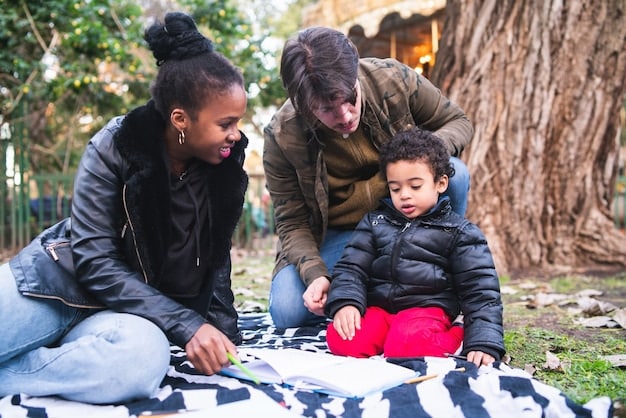Planning Family Vacations in the US: 2025 Guide

This guide provides comprehensive insights and strategic advice for families embarking on the journey of planning an unforgettable vacation in the US in 2025, from destination selection to budget management and activity planning.
Embarking on a family vacation can be a truly enriching experience, fostering bonds and creating lasting memories. Success hinges significantly on meticulous preparation, but the sheer volume of choices and considerations can often feel overwhelming. This guide, “Planning a Family Vacation in the US: The Ultimate Guide for 2025,” is designed to simplify that process, offering a clear, actionable roadmap to navigate the complexities of organizing a memorable trip within the United States.
Setting the Stage: Early Planning and Budgeting for Family Trips
The foundation of any successful family vacation in the US begins long before you pack your bags. Early planning is not just about securing bookings; it’s about aligning expectations, defining objectives, and, critically, establishing a realistic budget. This preliminary phase can significantly reduce stress and enhance the overall enjoyment of your trip, allowing for a more deliberate and thoughtful selection of destinations and activities tailored to every family member’s preferences.
One of the initial steps is to involve everyone in the conversation. Children, even young ones, can offer valuable input, especially regarding activities and attractions that excite them. This inclusive approach not only makes them feel invested in the journey but also ensures that the final itinerary reflects diverse interests, preventing potential disagreements or boredom once the vacation is underway.
Crafting a Realistic Budget
Budgeting for a family vacation extends beyond just airfare and accommodation. It encompasses a wide array of expenses that, if overlooked, can quickly derail your financial plan. A comprehensive budget should account for every possible cost, ensuring no surprises along the way.
- Transportation Costs: This includes flights, car rentals, gas, tolls, and any public transportation fees. Consider booking flights and rental cars well in advance, especially during peak seasons, to secure better rates and availability.
- Accommodation: Research various options, from hotels and resorts to vacation rentals (like Airbnb or VRBO) and even camping. Each offers different price points and amenities, catering to various family sizes and preferences. Look for options with kitchenettes or complimentary breakfast to save on food costs.
- Food Expenses: Factor in meals, snacks, and drinks. Eating out for every meal can be costly. Balance restaurant visits with self-prepared meals, picnics, and grocery store runs.
- Activities and Attractions: List all desired excursions, theme park tickets, museum admissions, and other entertainment. Many attractions offer family passes or discounts for booking online in advance.
- Miscellaneous and Contingency: Always allocate a portion of your budget for unexpected expenses or last-minute purchases. This buffer can prevent financial strain if unforeseen circumstances arise.
By meticulously detailing these categories, families can gain a clearer understanding of their financial commitment. Moreover, a well-defined budget can help in making informed decisions about where to splurge and where to save, ultimately ensuring that the vacation remains enjoyable and financially comfortable.
Consider creating a spreadsheet to track expenses as you plan and throughout the trip. This tool keeps you accountable and provides a clear picture of your spending, allowing for adjustments as needed. Remember, the goal is to create memories, not debt, making a robust budget an indispensable part of your vacation planning.
Choosing Your Adventure: Destination Selection Strategies
The United States offers an unparalleled diversity of landscapes, cultures, and attractions, making destination selection both exciting and challenging. For families, the key is to find a locale that caters to various age groups and interests, balancing adventure with relaxation.
Begin by considering the interests of everyone. Are your children fascinated by history, drawn to outdoor adventures, or do they dream of theme park thrills? Understanding these inclinations will significantly narrow down your options. For instance, a family with young children might prioritize destinations with kid-friendly activities and amenities, while teenagers might seek more adventurous or culturally immersive experiences.
Top Family-Friendly Destinations in the U.S.
Many destinations consistently rank high for family travel due to their wide appeal and abundant attractions. These typically offer a mix of entertainment, educational opportunities, and convenience.
- Orlando, Florida: Home to Walt Disney World, Universal Studios, and numerous water parks, Orlando remains a perennial favorite for families seeking magical experiences and endless entertainment. Beyond the major parks, there are also wildlife encounters and diverse dining options.
- Southern California (Los Angeles/San Diego): This region boasts diverse attractions, including Disneyland, Universal Studios Hollywood, stunning beaches, LEGOLAND California, and world-class zoos and aquariums. The variety ensures something for every age.
- National Parks (e.g., Yellowstone, Grand Canyon): For families who love nature and outdoor activities, the National Parks offer breathtaking scenery, hiking, wildlife viewing, and educational programs. These trips require more significant planning regarding lodging and food, but offer unparalleled opportunities for connection with nature.
- Washington, D.C.: A fantastic choice for history buffs and curious minds, offering free access to numerous Smithsonian museums, iconic monuments, and government buildings. It’s an educational trip that can be incredibly engaging for all ages.
While these are popular choices, consider less obvious destinations that might offer a unique experience. Smaller cities or regional attractions can sometimes provide a more intimate and budget-friendly alternative without sacrificing quality or fun. Researching local events, festivals, or seasonal offerings can also enhance your decision-making process.
Ultimately, the best destination is one that excites every member of your family and aligns with your overall vacation goals. Taking the time to research thoroughly and involve everyone in the decision will ensure a holiday that truly resonates with your family’s unique dynamics.

Crafting the Itinerary: Balancing Activities and Downtime
Once you’ve selected your destination, the next crucial step is to design an itinerary that maximizes enjoyment without leading to exhaustion. A well-structured itinerary balances planned activities with sufficient downtime, recognizing that over-scheduling can detract from the vacation experience.
Start by listing all the attractions and activities you wish to experience. Then, group them geographically to minimize travel time between locations. Consider the opening and closing times of attractions, as well as peak visitation hours, to plan your schedule strategically. For popular sites, purchasing tickets in advance can save valuable time and often money.
Incorporating Flexibility
While a plan is essential, rigidity can be detrimental, especially when traveling with children. Kids thrive on spontaneity and can quickly become overwhelmed by a packed schedule. Building in flexibility allows for unexpected discoveries, impromptu breaks, or changes in mood.
- Designate Free Days: Include days with minimal or no planned activities. These can be used for revisiting favorite spots, exploring local neighborhoods, or simply relaxing at your accommodation.
- Account for Travel Time: Always overestimate the time required for travel between locations, especially in unfamiliar cities or during peak traffic hours. This prevents rushing and reduces stress.
- Build in Buffer Time: Leave gaps between major activities. This allows for leisurely meals, unexpected detours, or simply a chance to rest and recharge before the next adventure.
- Have Backup Plans: Weather can be unpredictable, and attractions might close unexpectedly. Have a list of alternative indoor activities or less weather-dependent options ready.
Involving children in creating the itinerary can also be beneficial. Let them choose one or two activities they are most excited about. This gives them a sense of ownership and ensures they have something specific to look forward to, making them more cooperative during other parts of the trip.
Remember that a vacation is supposed to be relaxing and rejuvenating. Don’t feel pressured to see everything. Prioritize quality over quantity, and focus on creating meaningful experiences that everyone will cherish long after the trip is over. A balanced itinerary is key to a truly enjoyable family vacation.
Accommodation & Transportation: Making Smart Choices
The choices you make regarding accommodation and transportation can significantly impact your family’s comfort, convenience, and overall travel budget. Planning these aspects strategically is vital for a smooth and enjoyable trip.
When selecting accommodation, consider not only the price but also the amenities and location. For families, features like connecting rooms, laundry facilities, a pool, or complimentary breakfast can offer immense value. Vacation rentals, apart from offering more space and often kitchen facilities, can also provide a more “homey” feel, which is desirable for longer stays.
Navigating Transportation Options
Your choice of transportation will largely depend on your destination and itinerary. The US offers a variety of options, each with its own advantages and disadvantages.
- Flights: For long distances, air travel is usually the quickest option. Book flights well in advance, especially for peak travel times, and consider flying on weekdays or during off-peak hours for better rates. Look into direct flights to minimize stress with children.
- Car Rentals: Renting a car offers maximum flexibility, allowing you to explore at your own pace and reach less accessible attractions. Ensure you book an appropriately sized vehicle for your family and luggage. Factor in the cost of gas and parking.
- Trains (Amtrak): For scenic routes or travel between major cities, Amtrak can be a relaxing alternative to flying, especially with kids who appreciate the freedom to move around. It’s often more spacious than air travel and offers dining cars.
- Public Transportation: In major cities, utilizing subways, buses, or streetcars can be cost-effective and efficient. Research passes or family discounts. Ridesharing apps (Uber/Lyft) provide convenience for shorter distances.
When traveling with infants or young children, remember to arrange for car seats or booster seats if renting a car. Many rental companies offer these, but it’s often more cost-effective and safer to bring your own if feasible. If relying on public transport, ensure it’s accessible for strollers or mobility aids.
For longer road trips, planning regular stops every few hours is crucial to prevent fatigue and allow children to stretch their legs and burn off energy. Consider packing a cooler with drinks and snacks to avoid frequent, expensive stops. Effective planning for accommodation and transportation sets the stage for a comfortable and stress-free journey.
Packing Smart: Essentials and Keeping Kids Entertained
Packing for a family vacation can feel like a monumental task, but a strategic approach can streamline the process. The goal is to pack efficiently, ensuring you have all essentials without overdoing it, which can lead to cumbersome luggage and extra fees.
Start by making a comprehensive packing list, categorizing items by person and type (clothing, toiletries, medications, documents, entertainment). Check the weather forecast for your destination to pack appropriate clothing, but also include layers for unexpected temperature changes.
Keeping Kids Entertained on the Go
Long travel days, whether by car, plane, or train, can test the patience of both children and parents. Having a dedicated entertainment kit can make a significant difference, transforming potentially stressful periods into manageable ones.
- Screen Time: Download movies, TV shows, and educational apps onto tablets or phones. Don’t forget headphones and portable chargers.
- Analog Entertainment: Pack small, portable games, coloring books, crayons, activity books, or a deck of cards. These provide alternatives to screens and encourage creativity.
- Snacks: A variety of non-perishable snacks is crucial. Hunger can quickly lead to meltdowns. Choose options that are not messy and easy to consume on the go.
- Comfort Items: A favorite blanket, stuffed animal, or neck pillow can provide comfort and familiarity in new environments, helping children feel more secure.
- Surprise New Items: For longer trips, consider wrapping a few new, small toys or books. These “surprises” can be doled out strategically when patience wears thin, providing a fresh distraction.
Beyond entertainment, think about practical items. A small first-aid kit with bandages, antiseptic wipes, and pain relievers is always a good idea. Portable hand sanitizer, wet wipes, and plastic bags (for trash or wet clothes) are also invaluable. For infants, ensure you have enough diapers, formula, and any specialized feeding equipment.
Involve older children in packing their own small backpack with essentials they might want easy access to during travel. This teaches responsibility and ensures their most cherished items are at hand. Remember, less is often more when it comes to luggage, but preparedness is key to a smooth journey.
Safety First: Health and Emergency Preparedness
While the focus of a family vacation is on fun and relaxation, it’s essential to prioritize safety and be prepared for unforeseen circumstances. A proactive approach to health and emergency planning can provide peace of mind and help manage any unexpected challenges that arise.
Before you depart, ensure all family members’ vaccinations are up to date. Pack any prescription medications in your carry-on bag, along with copies of prescriptions and doctors’ notes if necessary. It’s also wise to research urgent care centers or hospitals near your destination, just in case.
Essential Safety Measures and Preparations
Being prepared means thinking ahead about potential risks and having a plan to address them. This includes everything from minor injuries to more serious emergencies.
- First-Aid Kit: A well-stocked first-aid kit is non-negotiable. Include basic supplies like bandages, antiseptic wipes, pain relievers (for adults and children), allergy medication, and any specific items your family might need (e.g., asthma inhalers, EpiPens).
- Travel Insurance: Consider purchasing comprehensive travel insurance. This can cover medical emergencies, trip cancellations, lost luggage, and other unforeseen events, providing a critical financial safety net.
- Emergency Contacts: Create a list of essential contacts, including doctors, emergency services at your destination, and family members not traveling with you. Share this list with older children.
- Child Safety: If staying in a vacation rental, assess the space for child-proofing needs. Teach children what to do if they get separated from you in a crowd (e.g., find a uniform or ask a family with children for help). Consider using child ID bracelets with contact information.
- Sun Protection and Hydration: Pack sunscreen, hats, and sunglasses, especially for outdoor activities. Emphasize regular hydration, particularly in warm climates, to prevent heat-related illnesses.
Discuss basic safety protocols with your children before the trip. This might include instructions on what to do if they get lost, how to identify safe adults, and the importance of staying together. Establishing these ground rules can empower them while also giving you confidence.
While it’s important to be prepared, try not to let safety concerns overshadow the joy of the trip. A balanced approach ensures you’re ready for anything while still being able to relax and enjoy the precious time with your family. Prevention and preparedness are your best allies for a safer vacation experience.
Making Memories: Capturing Moments and Reflecting on the Journey
Beyond the planning and logistics, the ultimate goal of any family vacation is to create lasting memories. Actively seeking opportunities to capture these moments and reflecting on the journey itself can amplify the positive impact of your trip, turning transient experiences into cherished recollections.
Encourage family members to actively engage with their surroundings. This goes beyond just taking photos; it involves truly experiencing each moment, from savoring new foods to marveling at a scenic vista. These shared experiences, big and small, are the building blocks of enduring memories.
Creative Ways to Capture and Cherish Memories
Don’t let your vacation memories fade away. There are numerous ways to document your trip that go beyond simple photos, creating tangible keepsakes that can be revisited for years to come.
- Photo Albums/Scrapbooks: Curate your favorite photos into a physical album or a digital slideshow. Enhance it with captions, dates, and small anecdotes. Consider creating a family scrapbook with tickets, postcards, and other mementos.
- Travel Journal: Encourage family members, especially older children, to keep a travel journal. They can jot down thoughts, observations, funny moments, and sketch scenes. This provides a personal narrative of the trip.
- Video Montage: Short video clips can capture the energy and sounds of your vacation in a way photos cannot. Compile them into a fun family video montage set to music.
- Souvenirs with Stories: Instead of generic trinkets, look for souvenirs that have a story or special meaning related to your experiences. These can be small crafts made by local artisans, unique food items, or natural elements like interesting rocks or shells (where permitted).
- Post-Trip Reflection: After returning home, set aside time for a “family debrief.” Look at photos, share favorite moments, and talk about what everyone enjoyed most. This collective reflection reinforces the positive memories.
Involve children in the memory-making process. Let them be the designated photographers for a day, or ask them to choose their favorite photo to be printed and framed. Their unique perspectives can often capture unexpected and delightful moments.
Remember that the true value of a family vacation lies not just in the destinations visited or activities undertaken, but in the shared laughter, the quiet moments of connection, and the collective growth experienced. Nurturing these memories ensures that the joy of the trip continues long after the suitcases are unpacked, becoming a cherished part of your family’s story.

Post-Vacation Wrap-Up: Extending the Joy
The return home doesn’t mean the end of your family vacation’s positive impact. A thoughtful post-vacation wrap-up can help extend the joy, solidify memories, and even improve future travel experiences. This final phase is about integration and appreciation, transforming a temporary escape into a lasting sense of well-being.
Allow for a period of readjustment upon returning. Avoid scheduling demanding activities immediately after your trip. Give everyone, especially children, time to settle back into routines and process their experiences. This can prevent the “post-vacation blues” and help preserve the positive feelings from the journey.
Organizing and Preserving Memories
One of the most rewarding aspects of the post-vacation phase is organizing the memories you’ve collected. This isn’t just about tidiness; it’s about making those memories accessible for future enjoyment and reflection.
- Digital Photo Management: Immediately upload and back up all photos and videos. Create dedicated folders for each trip, and consider using cloud storage services. Take the time to delete blurry duplicates and organize images chronologically or by theme.
- Physical Keepsakes: Unpack souvenirs, tickets, and other mementos. Decide what to keep and how to display or store them. A designated “vacation memory box” can be a wonderful repository for these treasures.
- Share Experiences: Share your photos and stories with extended family and friends. This communal sharing not only reinforces your own memories but also allows others to partake in your journey.
- Create a Memory Book/Video: As discussed, compiling a photo album, scrapbook, or video montage can turn a disparate collection of images into a cohesive narrative. Involve the children in this process; it’s a fun family activity.
Beyond organizing tangible memories, take time to reflect on what went well and what could be improved for future trips. Did you pack too much or too little? Were there activities that particularly resonated with the whole family? Did the budget hold up? These insights are incredibly valuable for refining your family’s travel style and planning even better adventures next time.
The post-vacation period is a crucial extension of the travel experience itself. By consciously wrapping up your trip, you solidify the joy, reinforce bonds, and ensure that the memories created truly last a lifetime. It’s a gentle landing after an exciting journey, preparing everyone for the next adventure on the horizon.
| Key Aspect | Brief Description |
|---|---|
| 📊 Budgeting | Essential for covering flights, lodging, food, activities, and a contingency fund. |
| 📍 Destination Choice | Select places catering to varied family interests, from theme parks to national parks. |
| 🗓️ Itinerary & Flexibility | Balance planned activities with downtime; include buffer and free days for spontaneity. |
| ⚕️ Safety & Health | Pack a first-aid kit, consider travel insurance, and have emergency contacts ready. |
Frequently Asked Questions About Family Vacations
▼
The “best” time significantly depends on your destination and desired activities. Summer (June-August) is popular for national parks and beaches, but also means larger crowds and higher prices. Spring (April-May) and Fall (September-October) offer milder weather and fewer tourists, ideal for city excursions and outdoor adventures. Winter brings unique opportunities for snow sports or warm-weather escapes to states like Florida.
▼
Consider vacation rentals (like Airbnb or VRBO) which often provide more space, multiple rooms, and kitchen facilities, reducing dining out costs. Hotels offering complimentary breakfast, kitchenettes, or free parking can also lead to significant savings. Booking well in advance or looking for deals during off-peak seasons can also secure better rates for family-friendly options.
▼
For keeping kids engaged during travel, pack a mix of screen-based and analog entertainment. Download movies or games on tablets (with headphones!), bring coloring books, small portable games, or a deck of cards. Don’t forget a variety of mess-free snacks, their favorite comfort item (like a blanket), and possibly a few “surprise” new toys for longer stretches.
▼
Yes, travel insurance is highly recommended for family vacations. It provides a crucial safety net for unforeseen circumstances such as medical emergencies, trip cancellations due to illness, lost luggage, or unexpected travel delays. While you hope not to use it, the peace of mind knowing you’re financially protected against potential disruptions can be invaluable, especially when traveling with children.
▼
Involving children in the planning process is very important. It gives them a sense of ownership over the trip, making them more excited and cooperative. Allow them to choose an activity or two, or contribute ideas for destinations. This approach makes the vacation more personalized to their interests, reduces potential boredom, and creates shared anticipation for the upcoming adventure. It fosters a sense of teamwork.
Conclusion
Successfully planning a family vacation in the United States for 2025 demands a blend of thoughtful preparation, financial prudence, and an unwavering commitment to creating shared experiences. From the initial budgeting discussions and the exciting selection of a destination that truly resonates with every family member, to the meticulous crafting of an itinerary that balances adventure with crucial downtime, each step contributes to a memorable journey. Prioritizing safety through proactive health measures and smart packing ensures a comfortable and worry-free experience, while actively capturing and reflecting upon memories extends the joy long after the bags are unpacked. By embracing these strategies, families can transform the sometimes daunting task of vacation planning into an adventurous and rewarding collaborative effort, resulting in not just a trip, but a tapestry of cherished moments that strengthen bonds and leave an indelible mark on everyone involved.





